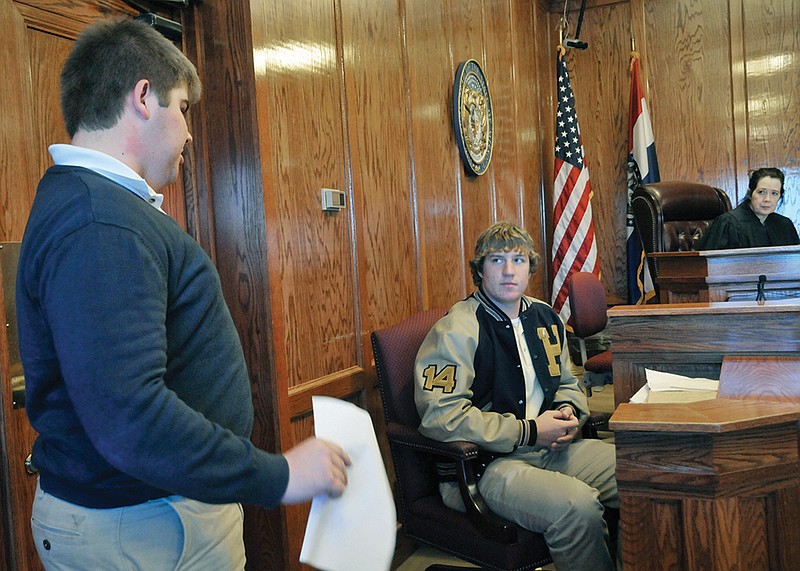Students from Helias and Rock Bridge High Schools were given an opportunity to try their hand at practicing the law on Tuesday in a mock trial competition at the Cole County Courthouse.
Helias and Rockbridge were two of eight schools from around the state selected to compete in the pilot project, the brainchild of Texas County Associate Circuit Judge Doug Gaston. Called "The Constitution Project," the competition is designed to give high school students hands-on experience in careers integral to the U.S. Constitution.
The project has students participate in a fictitious crime, working the case from the initial crime scene through the process to the final outcome of a mock trial. Faux investigators, journalists and lawyers all participated in the process, assisted and guided by real-life advisors. Real-life attorneys judged their performances by awarding, and deducting points.
After offering some introductory remarks, the trial started on Tuesday when Gaston announced: "Court is now in session!"
Brett Stover, a Rock Bridge student who served as the "prosecutor," launched into his opening.
"I aim to prove that Betty Quick (played by Peyton Hall) was involved in a reckless act that caused injury," he said.
According to the facts of the case, Stover hoped to prove that Quick was texting and driving while traveling on Providence Road in Columbia. A passenger in her car, Sally Ride (played by Madi Mertz), suffered fractured vertebrae when Quick crashed the car into a utility pole. Quick then left the scene of the accident. She was charged with second-degree assault, a class C felony.
The defense team, represented by the Helias students John Rhea and Nick Bruemmer, attempted to make the case that Quick actually swerved to avoid hitting a dog that darted into the road and left the scene to look for help.
Gaston served as the judge in the case and other teen students served as jurors. Upstairs in the courthouse, a similar scene played out in Cole County Presiding Judge Pat Joyce's courtroom.
As the trial unfolded, Gaston served up advice to the students.
"Be in charge. Be confident," he exhorted. "But if you get stumped, and need help, ask for a sidebar and approach the bench."
Throughout the trial, the testimony centered on: who saw the stray dog; how many minutes passed between when Quick sent a text and when the 911 call was placed; and who actually sent the text.
At first the Helias defense team was hesitant at interjecting objections into the trial. But after some encouragement from attorney Jason Call they grew bolder. They tried to make the case that possibly the passenger, herself, sent the text, not the car's driver.
"Don't be afraid to make an objection ... if it helps your client," Call said, demonstrating how they should pepper witnesses with questions. "Your job is to create doubt in the jury's mind!"
A breakthrough came when Bruemmer asked Sally Ride: "If you don't remember anything before the accident, how do you know you weren't the one holding the phone?"
"Oh! Don't put me on the spot," Ride cried.
Gaston was delighted by the exchange.
"See? That's how the truth comes out," he said.
Later in the case, Rhea asked Ride: "How can you say you're not qualified to answer the question, but still say you know - 100 percent - what happened that day?"
She replied: "Let me rephrase ... I'm not at liberty to say..."
The courtroom cracked up when Rhea uttered in stentorian tones: "It seems like you're hiding something!"
Gaston asked the students sitting on the jury to "take away your school colors and try to be objective as a jury." But he also said, in a real trial, they wouldn't be allowed to sit on the jury because of such biases.
He said all the players have the same basic job to do, no matter what team they are on.
"The job isn't to win the case. The job is, everybody has to find the truth. That takes the pressure off you as an attorney," he said. "Our most important right is a trial by jury."
Although the defense team won the mock trial on Tuesday, the students won't know which team won the competition until today. The students will be judged on the quality of their work.
With the project, Gaston hoped to instill a love of the U.S. Constitution.
"Today we fight the good fight," he said. "Today we fight for truth. Today we fight for justice. Today we fight for freedom."

